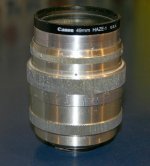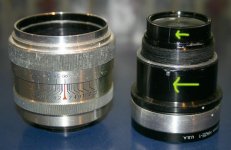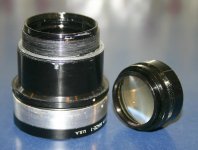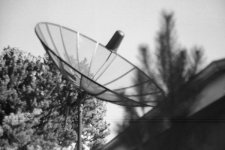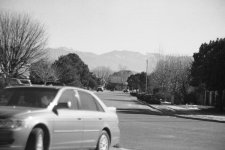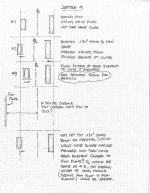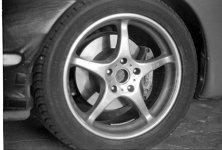Jeff_S
Member
I thought I would post this thread in this forum, I had PM'd Brian earlier about this lens so I wanted to continue the conversation here.
I have a '63 vintage J9 which I want to service. Helicoids aren't too bad but if it looks like I can get the performance I want out of it I will re-lube (or have it re-lubed).
When I originally bought the lens it performed OK but I would like to see if I can get it a little sharper, particularly at maximum aperture.
But here are a couple of questions first.
As you can see from the first photo, the aperture indicator ring is not lined up with the red dot. As a matter of fact it is on the other side of the lens barrel. There are three possible positions for this ring, when I loosen the screws and try all three none line up very well.
The second photo shows the lens pack out of the lens. You can see some scratch marks where someone (maybe the manufacturer - who knows) lined up the inner lens group.
Then the third photo shows this lens group removed from the lens pack. There was no shim in this inner group seat.
So what I've done is this. Using the procedure on Kim Coxin's site I set up another SLR and attempted to collimate this lens at infinity. I ended up removing both of the shims you see in the first photo. Checked focus at 1m and it seemed good. So I shot a few exposures, developed them, and found the lens was focusing behind.
So when we talk about removing or adding shims, where are we talking about? Where the two shims are shown in under the lens pack? Or inside the pack at the back group? And how do you know which ones to change? If I send the lens to a repairman to lube and collimate do they work with both areas? And last question (for now), is the rear group that didn't have a shim the difference between the silver and black J9's - is that where you have to file down the fixture to make a change?
Thanks in advance for any information you can give me.
Jeff
I have a '63 vintage J9 which I want to service. Helicoids aren't too bad but if it looks like I can get the performance I want out of it I will re-lube (or have it re-lubed).
When I originally bought the lens it performed OK but I would like to see if I can get it a little sharper, particularly at maximum aperture.
But here are a couple of questions first.
As you can see from the first photo, the aperture indicator ring is not lined up with the red dot. As a matter of fact it is on the other side of the lens barrel. There are three possible positions for this ring, when I loosen the screws and try all three none line up very well.
The second photo shows the lens pack out of the lens. You can see some scratch marks where someone (maybe the manufacturer - who knows) lined up the inner lens group.
Then the third photo shows this lens group removed from the lens pack. There was no shim in this inner group seat.
So what I've done is this. Using the procedure on Kim Coxin's site I set up another SLR and attempted to collimate this lens at infinity. I ended up removing both of the shims you see in the first photo. Checked focus at 1m and it seemed good. So I shot a few exposures, developed them, and found the lens was focusing behind.
So when we talk about removing or adding shims, where are we talking about? Where the two shims are shown in under the lens pack? Or inside the pack at the back group? And how do you know which ones to change? If I send the lens to a repairman to lube and collimate do they work with both areas? And last question (for now), is the rear group that didn't have a shim the difference between the silver and black J9's - is that where you have to file down the fixture to make a change?
Thanks in advance for any information you can give me.
Jeff


